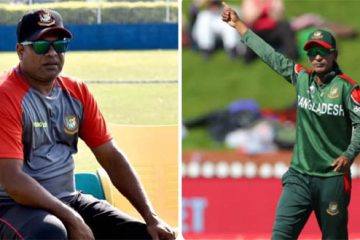It was the third day of the first Test against a second-string West Indies side in St. Vincent in mid-2009. There had been some rain around, but the big story of the match was that Bangladesh had lost their new skipper, Mashrafe Mortaza, during play the previous day.
Mashrafe, the team’s best bowler as well as their leader, had pulled up after bowling the third ball of his seventh over with an injury to his right knee. Into the breach stepped Shakib Al Hasan. His Test career had just completed its second year, and he now found himself in a quite unfamiliar position; leading the country in a Test they were expected to win, and that too with a strike bowler shy of a full attack.
The West Indies opener, Omar Phillips, was batting well, and threatening to make short shrift of the visitors’ first innings total of 238. The stand-in skipper, after lunch, had instructed his bowlers to bowl a tight line just outside off stump and packed the infield with run-saving fielders. Soon, one of the fielders on the offside, Rokibul Hasan, was brought closer in and positioned in an unusually square short cover. Sure enough, Omar Phillips, who had displayed the tendency to drive in the air square on the off side, drove on the up straight to Rokibul off Rubel Hossain, in the process falling six short of a morale-boosting century.
That dismissal of Omar Phillips hinted at a cricketing mind the sharpness of which Bangladesh had been missing all through their existence as one of cricket’s elite teams. Let alone Bangladesh, it is a shrewdness few international captains exhibit in the era of burgeoning backroom staff and computer analysis. Above all, it showed Shakib’s propensity to think on his feet rather than be tutored by the coach and backroom staff during the breaks.
It is no coincidence, therefore, that Shakib is the ideal man to lead the team into a new era of competence and strength. As a captain he is the most aggressive Bangladesh have had, and with him at the helm, the previous era of ‘just competing is enough’ has been truly put to rest. It helps also that his performances with both bat and ball are stellar, never more so than during last year’s 4-0 drubbing of New Zealand. He leads by example, but it is not just the example of his cricketing skills, it is an example of attitude.
One of cricket’s abiding myths is that a captain is as good or bad as his team. Bangladesh’s example proves that it is only partly true. A good captain lifts an underachieving team into a competitive one. An ordinary one makes sure that underachievers stay underachievers. One can only imagine how deflating it was to watch a captain play out the last over of an ODI match as a maiden, that too against a part-time bowler.
That is exactly what Mohammad Ashraful did in the first match of the Kitply Cup against Pakistan when he played out a maiden against Younis Khan in his quest to see his side not bowled out, and thereby be ‘competitive’. Yet, with the same team, and only a month later, Bangladesh trounced the West Indies in their backyard. The only difference was the captain. Contrast the last over maiden with the six Shakib hit off express bowler Kemar Roach to seal the second Test, and you will get a clearer picture of the change in attitude he brings.
With all things Bangla-deshi, however, comes a cautionary reminder. On occasion, Shakib has displayed a fiery temper and has not been shy of making the odd controversial statement; once even saying that it was not his team and thereby seeming to evade responsibility. He should remember that the best captains are those who unite teams under one banner and create an environment in which all the talent on offer can be expressed and fulfilled. This is his team, and that lesson would be a good one to take into the World Cup and beyond.




















